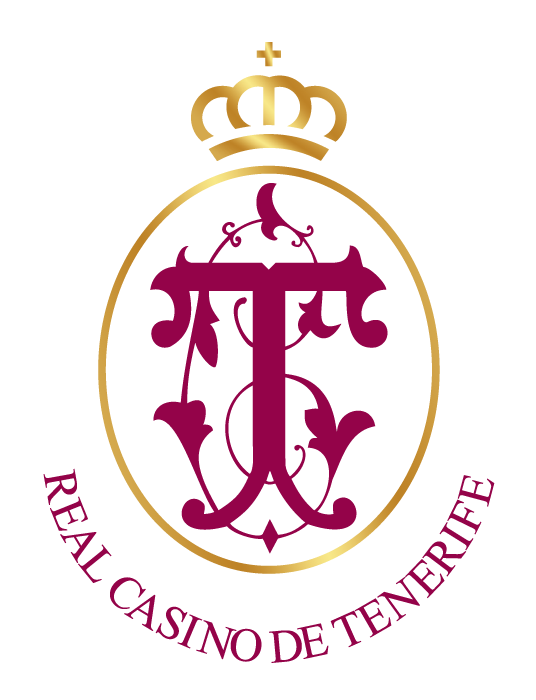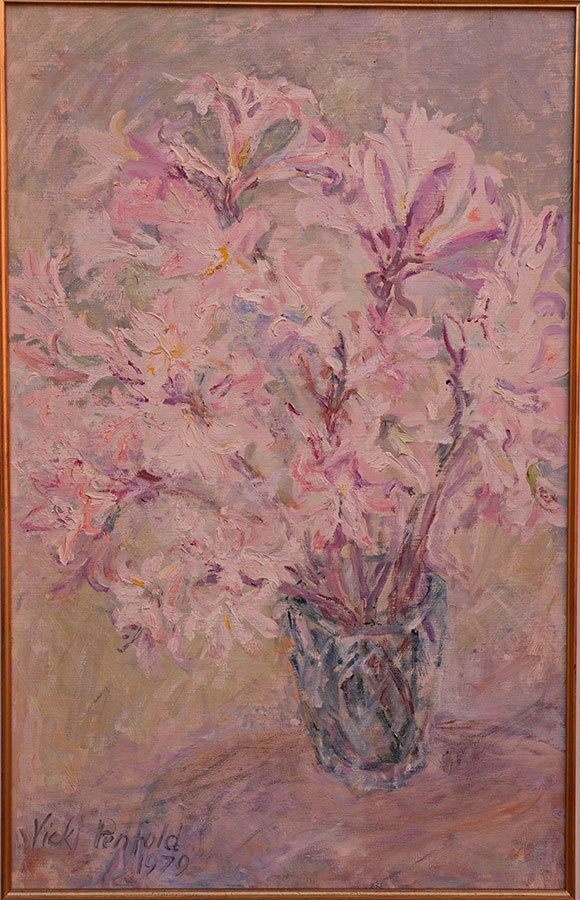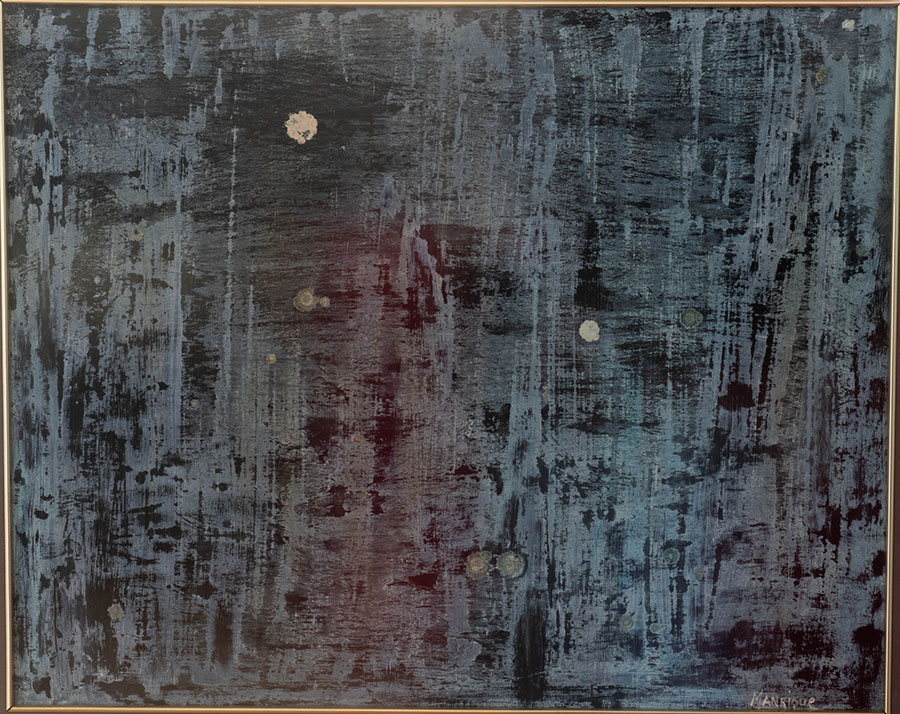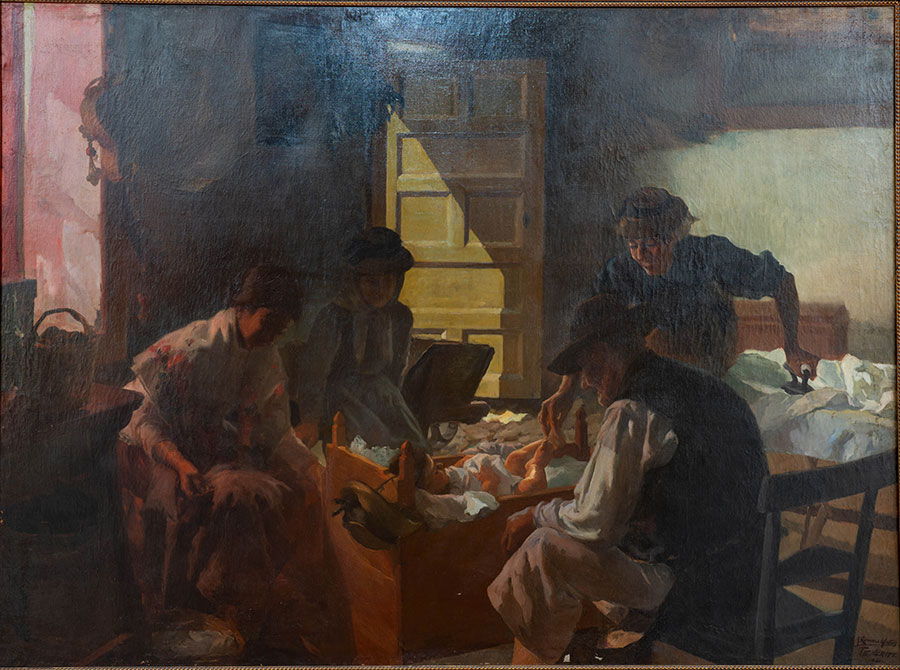
- Type of work: Easel painting
- Technique: Pending
- Approximate dimensions: 99 x 80 cm
- Theme: Intimate with a marked mystical character.
- Title: Woman and rose
- Author: Cristino de Vera (*1931)
- Chronology or Year: Signed in 1977, but completed in 1981.
- Historical-artistic analysis:
Style: Within the figurative style, it is not a mimetic reference to reality, since it refers to a hidden design.
Description. The figure of a woman, whose expressiveness is supported by her hands clasped together holding a rose, seems to float in an abstract setting. The apparent simplicity of the representation hides a compositional complexity, where the coexistence of different vanishing points creates an ambiguous and fractured space. A geometric composition of chromatic planes, where the vertical frontal stripe is opposed to the lateral foreshortening of another plane, reduces the background to two-dimensionality, to autonomous color fields delimited by the line; to this pictorial plane he contrasts the spaciousness suggested by the drawing in the construction of the figure, a drawing that is nevertheless hidden by the application of color like the weft of a fabric, creating a homogeneous texture where there is no atmospheric perspective or distance. This ambiguity is accentuated by the treatment of light, which is not at the service of reality but rather its transfiguration. With short, dry brushstrokes, it is the white background of the painting that lightens the chromatic mass and brings out the light from within, expanding over the entire surface, underlining the silence and emptiness in which the female figure is suspended, petrified. The contrast of planes has been interpreted as an allegory of an unreconciled, fragmented world, an environment in which the solitary, static woman evokes, in a serene attitude, the eternal wait for reconciliation.
Date of reception: The work was acquired by the Casino during the presidency of Don Opelio Rodríguez Peña. (1979 – 1989)
Observations: In 1977, date of execution of the painting, Cristino Vera makes a solo exhibition at the Municipal Museum of Fine Arts of Santa Cruz de Tenerife and the following year participates in Collective both in Tenerife and Las Palmas. His presence in the Canary Islands in these exhibitions was perhaps the occasion that motivated the acquisition by the Casino of one of his works for its collection.
About the Author: Born on December 15, 1931, Cristino de Vera began his training in 1946, at the Escuela de Artes y Oficios Artísticos in his hometown under the teachings of Mariano Cossío, complementing it with drawing classes at the studio of sculptor Alfonso Reyes, and continuing them in Madrid in 1951 with Daniel Vázquez Díaz, classes at the Escuela de Bellas Artes de San Fernando and frequent visits to the Prado. In 1954 he had his first individual exhibition at the Galería Estilo in Madrid, for which he was presented by José Ma Moreno. From then on, his work was periodically shown individually or in group exhibitions, such as the one at the Museo Nacional de Arte Contemporáneo in Madrid in 1959, before traveling to France and Italy with a scholarship from the March Foundation in 1960. In 1961 he participated in the II Paris Biennial, the following year in the Venice Biennial and in 1964 with the Spanish pavilion at the New York Fair. With an iconographic style configured already at the end of the fifties, his work acquires a coherence that he will maintain throughout his career, in which his vital coherence has found the way to express itself, in a full identification with his work. The Theo Gallery in Madrid became the setting for his subsequent exhibitions, with prologues by intellectuals of the time, including, among others, the intervention of Gerardo Diego in the 1968 show. In 1971 he held his first anthological exhibition at the Caja de Ahorros de Santa Cruz (in La Laguna) with texts by Pedro González, Jesús Hernández Perera, Domingo Pérez Minik, Enrique Lite and Julio Tovar. His art soon transcended borders and in 1973 his work was exhibited at the Suillerot Gallery in Paris and the following year at the Rutland Gallery in London. Trips to the Far East, India, Brazil or the USSR enriched his spirituality and gave his work a higher profile, shown in a second anthology organized by the City Council of Las Palmas de Gran Canaria in the Castillo de La Luz, in 1976, exhibited the following year in the Municipal Museum of Fine Arts of Santa Cruz de Tenerife. In his hometown he exhibited again in 1985, this time at Magda Lázaro’s gallery with which he attended Arco in 1990, repeating in 1992 and 1994, both times with the Madrid gallery La Máquina Española. In 1996 his artistic career was awarded with the Gold Medal of the Canary Islands, followed by the National Prize of Plastic Arts received in 1998, awards that culminated with the Gold Medal of Fine Arts in 2002.
Bibliography:
Archive of the Casino de Tenerife
Ramón SALAS LAMAMIÈ DE CLAIRAC: Cristino de Vera. Vice-Ministry of Culture and Sports. Government of the Canary Islands, Santa Cruz de Tenerife, 2002.




